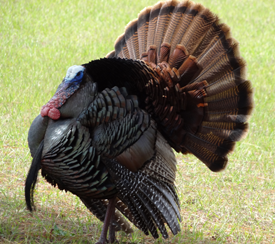 Osceola wild turkeys are often the last subspecies that many turkey hunters need to complete their grand slam. This is usually the case for several reasons. First, the Osceola turkey has a very limited range as it lives only on the peninsula of Central and South Florida. Because of the relative small territory that Osceola wild turkeys call home, there are not huge populations of Osceola turkeys. The total population of Osceola turkeys is estimated to be in the 100,000 range. In addition to the small population and territory, very few opportunities exist for hunting them on public land.
Osceola wild turkeys are often the last subspecies that many turkey hunters need to complete their grand slam. This is usually the case for several reasons. First, the Osceola turkey has a very limited range as it lives only on the peninsula of Central and South Florida. Because of the relative small territory that Osceola wild turkeys call home, there are not huge populations of Osceola turkeys. The total population of Osceola turkeys is estimated to be in the 100,000 range. In addition to the small population and territory, very few opportunities exist for hunting them on public land.
Many of the public hunting grounds do not have turkeys on them. Those that do have limited hunting opportunities so that the birds living there do not have an extreme amount of pressure on them. This is great if you are one of the lucky hunters who has the chance to hunt those few public lands with Osceola’s on them, but it is not great if you are someone like me who has a bad case of the Osceola turkey fever with an outbreak of the Grand Slam rash as well. Another reason the Osceola is usually the last turkey that hopeful Grand Slammers need is because of the high cost of hunting Osceola’s. The cost of hunting an Osceola is often two times the cost of hunting a Rio, Merriam’s, or Eastern wild turkey because of the limited range, population, and public hunting opportunities. Don’t tell the many outfitters in Central and South Florida this, but I probably would have paid more to hunt an Osceola. If you get the opportunity to go on a really good Osceola hunt, the experience is like nothing you’ve ever had.
The Osceola subspecies, named after Chief Osceola of the Seminole Indian Tribe, is very similar in appearance to the Eastern subspecies. The main noticeable differences between the Eastern and the Osceola subspecies are the darker color of the Osceola and less noticeable black and white banding of the wing feathers on the Osceola. The wing feathers of the Osceola are mostly black with narrow, irregular white bands. Another difference that I have noticed is the legs of Osceola wild turkeys seem to be longer compared to its body than the legs of the Eastern. This is, perhaps, due to thousands of years of walking in the Florida swamps, or maybe it is just my imagination. While the Eastern wild turkey has a great deal of bronze iridescence in its feathers, the Osceola wild turkey has more of a green iridescence to its feathers. The last difference that I have noticed is that Osceola wild turkeys can have very long spurs. Keep this and the fact that their legs are longer in mind when you go to pick up your trophy while it is still flopping. You don’t want to get spurred!
The Osceola turkey is a hard gobbling bird that sounds very similar to the Eastern subspecies. When an Osceola gobbles very close to you, you can hear a rattle in his throat, and you can almost feel the earth shake. These birds are very wary, and they are very challenging to kill. This wariness likely comes from the thick woods they inhabit and the large number of predators lurking in close quarters with them.
I have found that the exact same calls you use when hunting Eastern’s will work well for Osceola wild turkeys as well. Diaphragm calls and friction calls work very well to mimic the sounds of a female Osceola. For shock gobbling, a realistic crow or owl call are difficult to beat for locating gobbling birds.